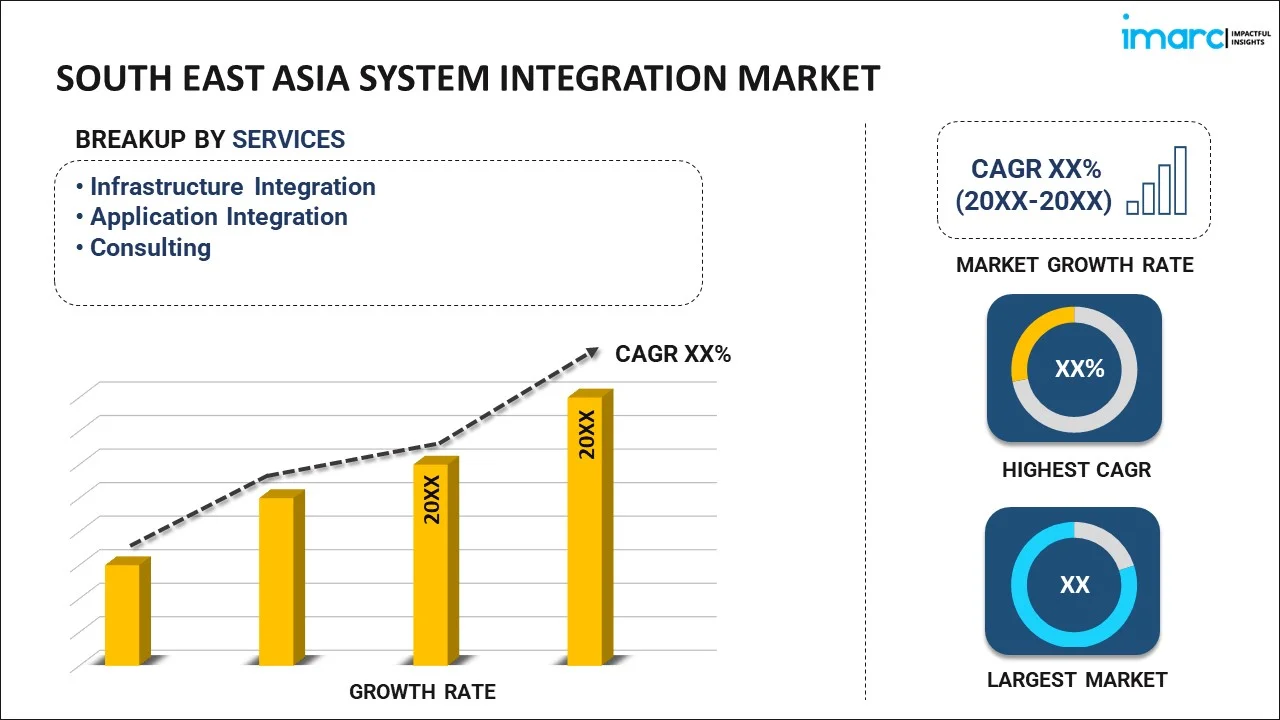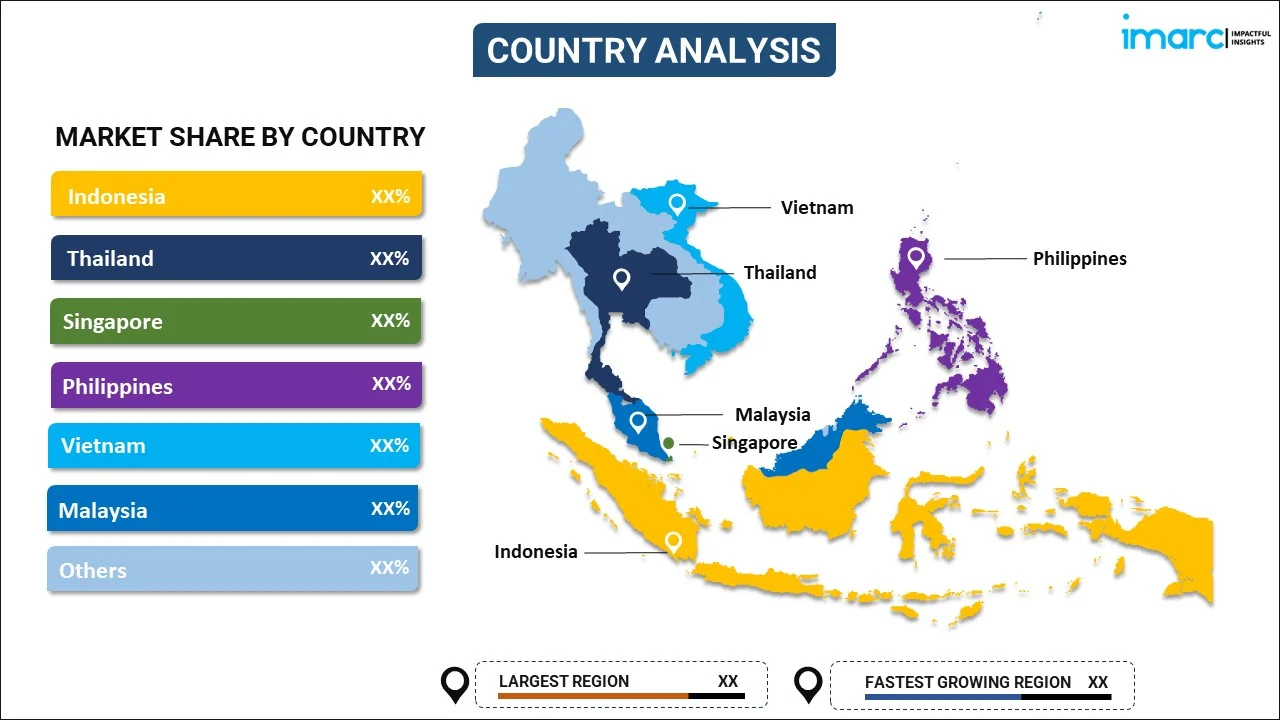
South East Asia System Integration Market Report by Service (Infrastructure Integration, Application Integration, Consulting), End Use Industry (BFSI, Government, Manufacturing, Telecommunications, Retail, Oil and Gas, Healthcare, and Others), and Country 2025-2033
Market Overview:
South East Asia system integration market size is projected to exhibit a growth rate (CAGR) of 9.33% during 2025-2033. Increasing digital transformation, thriving e-commerce industry, rising information technology (IT) complexity, surging cybersecurity needs, smart city initiatives, adoption of Industry 4.0, growing demand for cloud services, and ongoing technological innovation represent some of the key factors driving the market.
|
Report Attribute
|
Key Statistics
|
|---|---|
|
Base Year
|
2024 |
|
Forecast Years
|
2025-2033 |
|
Historical Years
|
2019-2024
|
| Market Growth Rate (2025-2033) | 9.33% |
System integration refers to the process of combining various computing systems and software applications, physically or functionally, to act as a coordinated whole. It involves connecting and coordinating diverse systems, subsystems, and components, often from different vendors, into a unified and efficient entity. The primary goal of system integration is to ensure seamless interoperability and collaboration among various elements within an information technology environment. This can include hardware devices, software applications, networks, and other technologies. System integration plays a crucial role in enhancing efficiency, streamlining operations, and maximizing the utility of existing information technology (IT) infrastructure. It enables organizations to optimize their processes, improve data flow and accessibility, and enhance overall system performance. Besides this, system integration offers integration of customer relationship management (CRM) systems with enterprise resource planning (ERP) systems, connecting legacy systems with modern applications and creating unified communication platforms that consolidate various communication channels. Successful system integration requires careful planning, thorough analysis of existing systems, and the implementation of interoperable technologies to create a cohesive and well-functioning IT ecosystem.
South East Asia System Integration Market Trends:
The increasing digital transformation initiatives across industries, with numerous organizations adopting advanced technologies such as cloud computing, artificial intelligence (AI), and the Internet of Things (IoT), are fueling the demand for system integration services. In confluence with this, the region's dynamic economic landscape and the rise of e-commerce, prompting enterprises to invest in robust and integrated IT solutions to enhance their operational efficiency and customer experience, is strengthening the market growth. Moreover, the growing complexity of IT environments, marked by a mix of legacy systems and modern applications, is aiding in market expansion, as system integration helps organizations harmonize these disparate elements, ensuring they function cohesively to meet business objectives. Besides this, the rising emphasis on data security and privacy spurring the adoption of integrated cybersecurity solutions to fortify defenses, safeguard sensitive data, and ensure regulatory compliance is acting as another significant growth-inducing factor. Concurrently, the flourishing expansion of smart cities and connected infrastructure projects, where system integration is integral to facilitate the seamless interaction and coordination of various components, such as sensors, networks, and data analytics platforms, is strengthening the market growth. In addition to this, the increasing adoption of Industry 4.0 practices prompting organizations to integrate their manufacturing and supply chain systems, thereby optimizing processes and enhancing overall operational efficiency, is contributing to the market expansion. Furthermore, the surge in demand for cloud services, the proliferation of mobile devices and favorable government initiatives, and investments in infrastructure development are presenting lucrative opportunities for the market growth.
South East Asia System Integration Market Segmentation:
IMARC Group provides an analysis of the key trends in each segment of the market, along with forecasts at the regional and country levels for 2025-2033. Our report has categorized the market based on service and end use industry.
Service Insights:

- Infrastructure Integration
- Application Integration
- Consulting
The report has provided a detailed breakup and analysis of the market based on the service. This includes infrastructure integration, application integration, and consulting.
End Use Industry Insights:
- BFSI
- Government
- Manufacturing
- Telecommunications
- Retail
- Oil and Gas
- Healthcare
- Others
A detailed breakup and analysis of the market based on the end use industry have also been provided in the report. This includes BFSI, government, manufacturing, telecommunications, retail, oil and gas, healthcare, and others.
Country Insights:

- Indonesia
- Thailand
- Singapore
- Philippines
- Vietnam
- Malaysia
- Others
The report has also provided a comprehensive analysis of all the major regional markets, which include Indonesia, Thailand, Singapore, Philippines, Vietnam, Malaysia, and Others.
Competitive Landscape:
The market research report has also provided a comprehensive analysis of the competitive landscape. Competitive analysis such as market structure, key player positioning, top winning strategies, competitive dashboard, and company evaluation quadrant has been covered in the report. Also, detailed profiles of all major companies have been provided.
South East Asia System Integration Market Report Coverage:
| Report Features | Details |
|---|---|
| Base Year of the Analysis | 2024 |
| Historical Period | 2019-2024 |
| Forecast Period | 2025-2033 |
| Units | Million USD |
| Scope of the Report | Exploration of Historical Trends and Market Outlook, Industry Catalysts and Challenges, Segment-Wise Historical and Future Market Assessment:
|
| Services Covered | Infrastructure Integration, Application Integration, Consulting |
| End Use Industries Covered | BFSI, Government, Manufacturing, Telecommunications, Retail, Oil and Gas, Healthcare, Others |
| Countries Covered | Indonesia, Thailand, Singapore, Philippines, Vietnam, Malaysia, Others |
| Customization Scope | 10% Free Customization |
| Post-Sale Analyst Support | 10-12 Weeks |
| Delivery Format | PDF and Excel through Email (We can also provide the editable version of the report in PPT/Word format on special request) |
Key Questions Answered in This Report:
- How has the South East Asia system integration market performed so far and how will it perform in the coming years?
- What has been the impact of COVID-19 on the South East Asia system integration market?
- What is the breakup of the South East Asia system integration market on the basis of service?
- What is the breakup of the South East Asia system integration market on the basis of end use industry?
- What are the various stages in the value chain of the South East Asia system integration market?
- What are the key driving factors and challenges in the South East Asia system integration?
- What is the structure of the South East Asia system integration market and who are the key players?
- What is the degree of competition in the South East Asia system integration market?
Key Benefits for Stakeholders:
- IMARC’s industry report offers a comprehensive quantitative analysis of various market segments, historical and current market trends, market forecasts, and dynamics of the South East Asia system integration market from 2019-2033.
- The research report provides the latest information on the market drivers, challenges, and opportunities in the South East Asia system integration market.
- Porter's five forces analysis assist stakeholders in assessing the impact of new entrants, competitive rivalry, supplier power, buyer power, and the threat of substitution. It helps stakeholders to analyze the level of competition within the South East Asia system integration industry and its attractiveness.
- Competitive landscape allows stakeholders to understand their competitive environment and provides an insight into the current positions of key players in the market.
Need more help?
- Speak to our experienced analysts for insights on the current market scenarios.
- Include additional segments and countries to customize the report as per your requirement.
- Gain an unparalleled competitive advantage in your domain by understanding how to utilize the report and positively impacting your operations and revenue.
- For further assistance, please connect with our analysts.
 Inquire Before Buying
Inquire Before Buying
 Speak to an Analyst
Speak to an Analyst
 Request Brochure
Request Brochure
 Request Customization
Request Customization




.webp)




.webp)












